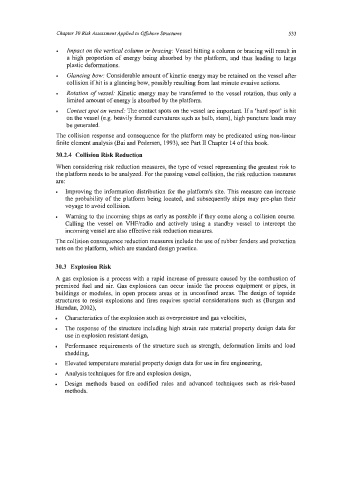Page 557 - Marine Structural Design
P. 557
Chapter 30 Risk Assessment Applied to Offshore Structures 533
Impact on the vertical column or bracing: Vessel hitting a column or bracing will result in
a high proportion of energy being absorbed by the platform, and thus leading to large
plastic deformations.
Glancing bow: Considerable amount of kinetic energy may be retained on the vessel afier
collision if hit is a glancing bow, possibly resulting from last minute evasive actions.
Rotation of vessel: Kinetic energy may be transferred to the vessel rotation, thus only a
limited amount of energy is absorbed by the platform.
Contact spot on vessel: The contact spots on the vessel are important. If a ‘hard spot’ is hit
on the vessel (e.g. heavily framed curvatures such as bulb, stern), high puncture loads may
be generated.
The collision response and consequence for the platform may be predicated using non-linear
finite element analysis @ai and Pedersen, 1993), see Part I1 Chapter 14 of this book.
30.2.4 Collision Risk Reduction
When considering risk reduction measures, the type of vessel representing the greatest risk to
the platform needs to be analyzed. For the passing vessel collision, the risk reduction measures
are:
Improving the information distribution for the platform’s site. This measure can increase
the probability of the platform being located, and subsequently ships may pre-plan their
voyage to avoid collision.
Warning to the incoming ships as early as possible if they come along a collision course.
Calling the vessel on VHF/radio and actively using a standby vessel to intercept the
incoming vessel are also effective risk reduction measures.
The collision consequence reduction measures include the use of rubber fenders and protection
nets on the platform, which are standard design practice.
30.3 Explosion Risk
A gas explosion is a process with a rapid increase of pressure caused by the combustion of
premixed fuel and air. Gas explosions can occur inside the process equipment or pipes, in
buildings or modules, in open process areas or in unconfined areas. The design of topside
structures to resist explosions and fires requires special considerations such as (Burgan and
Hamdan, 2002),
Characteristics of the explosion such as overpressure and gas velocities,
The response of the structure including high strain rate material property design data for
use in explosion resistant design,
Performance requirements of the structure such as strength, deformation limits and load
shedding,
Elevated temperature material property design data for use in fire engineering,
Analysis techniques for fire and explosion design,
Design methods based on codified rules and advanced techniques such as risk-based
methods.

